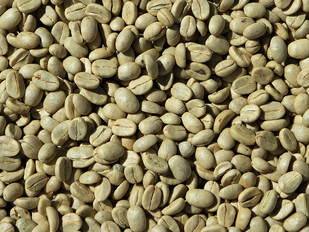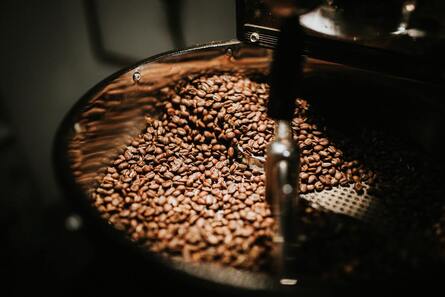
Buying the perfect harvest.
Just like grapes for wine, coffee beans carry the flavors and aromas of its place of origin.
Most coffee plantations "future" sell their best crops, meaning that the berries are sold before they are on the shrub. The remaining crop is sold to other distributors once the berries have blossomed. Every harvest is vulnerable to the changing weather conditions and pests.
However, buying the perfect coffee bean does not make the perfect cup of coffee. It is the roasting of the bean that is critical and differentiate flavors between brands.
Roasting is far more complex than simply purchasing the machine and adding the beans. Roasting allows the bean to reach its maximum flavor and aroma by exposing it to the precise amount of heat and carefully watching for time.
More than a commercial process, roasting is an art that combines chemical expertise with an exquisite palate and olfactory senses.
Just like grapes for wine, coffee beans carry the flavors and aromas of its place of origin.
Most coffee plantations "future" sell their best crops, meaning that the berries are sold before they are on the shrub. The remaining crop is sold to other distributors once the berries have blossomed. Every harvest is vulnerable to the changing weather conditions and pests.
However, buying the perfect coffee bean does not make the perfect cup of coffee. It is the roasting of the bean that is critical and differentiate flavors between brands.
Roasting is far more complex than simply purchasing the machine and adding the beans. Roasting allows the bean to reach its maximum flavor and aroma by exposing it to the precise amount of heat and carefully watching for time.
More than a commercial process, roasting is an art that combines chemical expertise with an exquisite palate and olfactory senses.

2. The process
Once the raw coffee beans arrive at the roaster location, they are poured into a giant hopper in order to remove any stained stone and other debris.
Then, the raw batch is thrown into enormous drums. The process begins when these drums apply centrifugal, centripetal forces and heat to the beans. After a few minutes, at a temperature of approximately 329° F, the batch undergoes an endothermic reaction where it absorbs the heat energy applied.
At this point the bean's moisture is evaporated and it is followed by the sound of the "first crack" (similar to the sound of a kernel popping). The beans undergo a physical change of color from green to yellow; this is a simple chemical reaction that fills the room with a smell of hay.
Shortly after, an exothermic reaction occurs where the beans release heat. This stage is characterized by the increase of up to 60 percent of the bean's volume and a decrease of up to 20 percent of the bean's weight due to the evaporation of water.
Following the first crack, the bean absorbs heat and begins to fracture. This process emits a sound known as the ‘second crack’. The interval between the first and second crack is between 15 to 30 seconds. This time frame is critical to the roasting process, as it is the indicator to stop roasting.
Each coffee brand has its own unique formula for a coffee blend and heat process. At Meza cafe we believe to stop before the second crack or on the verge of the second crack, because it is at this point that the bean is smooth with a slight gloss of aromatic oil. It is at this point that the essential flavors remain
We suggests not leaving the batch to roast until or after the second crack, which often leaves a burnt taste that overshadows the original flavor and aroma of the bean. (next)
Once the raw coffee beans arrive at the roaster location, they are poured into a giant hopper in order to remove any stained stone and other debris.
Then, the raw batch is thrown into enormous drums. The process begins when these drums apply centrifugal, centripetal forces and heat to the beans. After a few minutes, at a temperature of approximately 329° F, the batch undergoes an endothermic reaction where it absorbs the heat energy applied.
At this point the bean's moisture is evaporated and it is followed by the sound of the "first crack" (similar to the sound of a kernel popping). The beans undergo a physical change of color from green to yellow; this is a simple chemical reaction that fills the room with a smell of hay.
Shortly after, an exothermic reaction occurs where the beans release heat. This stage is characterized by the increase of up to 60 percent of the bean's volume and a decrease of up to 20 percent of the bean's weight due to the evaporation of water.
Following the first crack, the bean absorbs heat and begins to fracture. This process emits a sound known as the ‘second crack’. The interval between the first and second crack is between 15 to 30 seconds. This time frame is critical to the roasting process, as it is the indicator to stop roasting.
Each coffee brand has its own unique formula for a coffee blend and heat process. At Meza cafe we believe to stop before the second crack or on the verge of the second crack, because it is at this point that the bean is smooth with a slight gloss of aromatic oil. It is at this point that the essential flavors remain
We suggests not leaving the batch to roast until or after the second crack, which often leaves a burnt taste that overshadows the original flavor and aroma of the bean. (next)
